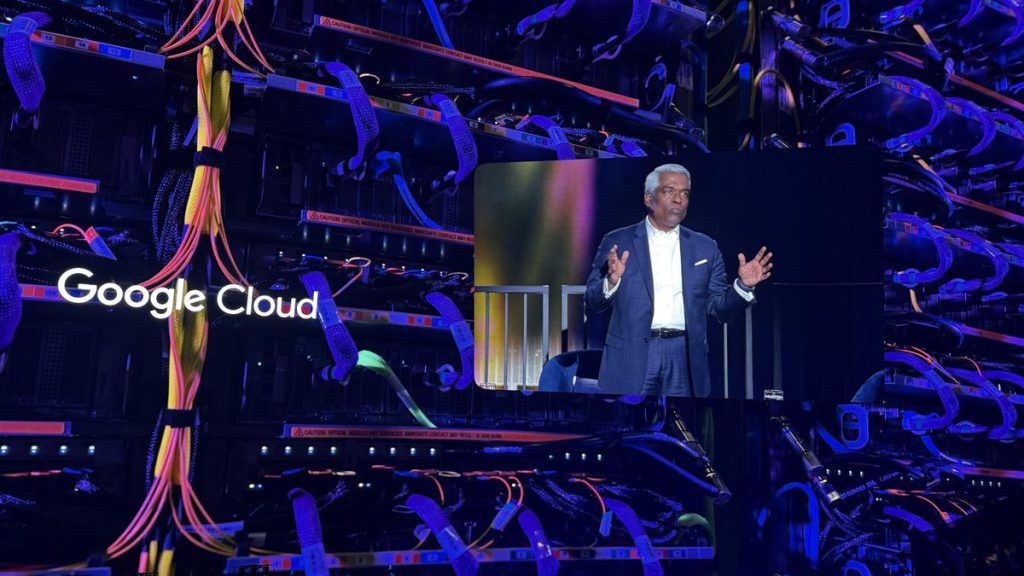At Google Cloud Next ‘25, Thomas Kurian, CEO of Google Cloud, took the stage to unveil a series of groundbreaking innovations, focusing heavily on artificial intelligence (AI), cloud infrastructure, and new tools for developers and enterprises. Key announcements includes advances in distributed cloud that lets users bring Gemini models on premises, seventh generation Tensor Processing Units (TPUs), and multi-agent ecosystems, setting the stage for the future of business AI.
One of the most prominent highlights was the introduction of Ironwood, Google’s seventh-generation TPU, which delivers a staggering 42.5 exaflops of compute per pod. Ironwood, which utilises over 9,000 chips per pod, is tailored to meet the demands of sophisticated models like Gemini 2.5. The enhanced performance capabilities of Ironwood, coupled with Google’s Cluster Director tool, will allow businesses to deploy and manage massive compute clusters efficiently, reducing costs while maximizing computational power. These innovations were met with strong industry interest, as the need for faster, more scalable AI models grows exponentially.
Further augmenting Google Cloud’s AI capabilities, Google Distributed Cloud (GDC) will bring the Gemini models to on-premises environments, offering flexibility for organizations that must operate within strict regulatory or data sovereignty constraints. By partnering with companies like NVIDIA and Dell, Google is enabling local use of advanced models in both air-gapped and connected environments. This development is a major step forward for industries dealing with highly sensitive data, ensuring the latest AI technology is accessible without compromising security or compliance.

The Agent Development Kit (ADK) was another pivotal announcement at Cloud Next. This open-source framework makes it easier for developers to build sophisticated multi-agent systems with minimal code—less than 100 lines. Additionally, Google introduced the Agent2Agent Protocol (A2A), a first in the cloud industry, allowing different AI agents to communicate across diverse technologies. Kurian described this as a transformative step, noting that “By allowing agents to interact seamlessly, we are helping organizations build complex, collaborative systems that work together autonomously.”
Building on the momentum of multi-agent systems, Google Agentspace promises to empower every employee with access to AI agents. The new platform provides users with pre-built connectors to search and transact with data across their organization, transforming how businesses utilize AI to enhance employee productivity. With tools like NotebookLM already in use by over 100,000 businesses, Agentspace is designed to assist employees find, synthesise, and act on critical information. As Mr. Kurian stated, “We’re putting AI into the hands of everyone in the enterprise, making it easier to access and leverage valuable insights at scale.”
Among the many other innovations, Vertex AI stood out as a comprehensive platform for managing AI workloads. With new features like the Vertex AI Model Optimizer, Google is enhancing AI model deployment by optimising queries based on customer preferences for speed, quality, and cost. This makes it easier for enterprises to manage complex AI tasks without sacrificing efficiency. The Live API, which facilitates real-time interaction with AI models through streaming audio and video, opens new possibilities for immersive, multimodal applications.
On the creative side of AI, Google introduced Imagen 3, its most advanced text-to-image model, which now includes enhanced capabilities for image generation and in-painting. With improved object removal and seamless editing, Imagen 3 raises the bar for visual creativity. Additionally, Chirp 3, an audio generation model, allows businesses to create personalized voices with just 10 seconds of input. This technology promises to revolutionize customer service, enabling companies to establish unique brand voices while maintaining consistency across various media.
Google also showcased its Lyria model, the first enterprise-ready text-to-music AI, which enables businesses to create high-fidelity soundtracks for marketing campaigns, podcasts, and other digital content. This breakthrough in AI-powered audio composition opens up new opportunities for creative expression, allowing organizations to produce professional-grade music for a variety of applications.
In the realm of video generation, Veo 2 saw significant upgrades, transforming it from a basic video creation tool to a full-fledged platform capable of sophisticated editing and visual effects. Features such as out-painting and in-painting allow users to extend and refine videos, while cinematic techniques like shot composition and camera angles enable more polished, professional results. Veo’s ability to generate and modify video at scale presents new opportunities for content creators and businesses alike.
Lastly, Google’s investment in AlphaFold 3, an AI model designed to predict protein structures with unparalleled accuracy, represents a major advancement in scientific research. Now available through Google Cloud, AlphaFold 3 promises to accelerate discoveries in fields like medicine and biotechnology, enabling faster, more accurate research.
In a year where AI has firmly cemented its place in business strategy, Google Cloud is looking to position itself at the forefront, offering a comprehensive suite of AI tools and infrastructure to help organisations leverage the power of machine learning and cloud technologies.
Other notable announcements at Cloud Next 2025 include Cloud Wide Area Network (Cloud WAN), Vertex AI, and Google Workspace.

Cloud WAN is a fully managed enterprise backbone that taps into Google’s vast private network. This new offering promises up to 40% improvement in network performance while reducing costs, providing businesses with “Google-speed” connectivity, characterized by near-zero latency.
Vertex AI, Google’s comprehensive platform for building and managing AI applications, saw significant upgrades. With over 200 models now available, including first-party models like Gemini and third-party offerings from companies such as Anthropic and Mistral, Vertex has experienced a 20x growth in usage over the past year.
Google Workspace received new AI features, including “Help Me Analyze” in Sheets, which identifies data insights automatically, and “Docs Audio Overview,” which converts text documents into high-quality audio summaries, enhancing productivity across industries.
(The writer was invited to the Google Next ’25 event at Las Vegas, Nevada)
Published – April 09, 2025 05:31 pm IST

